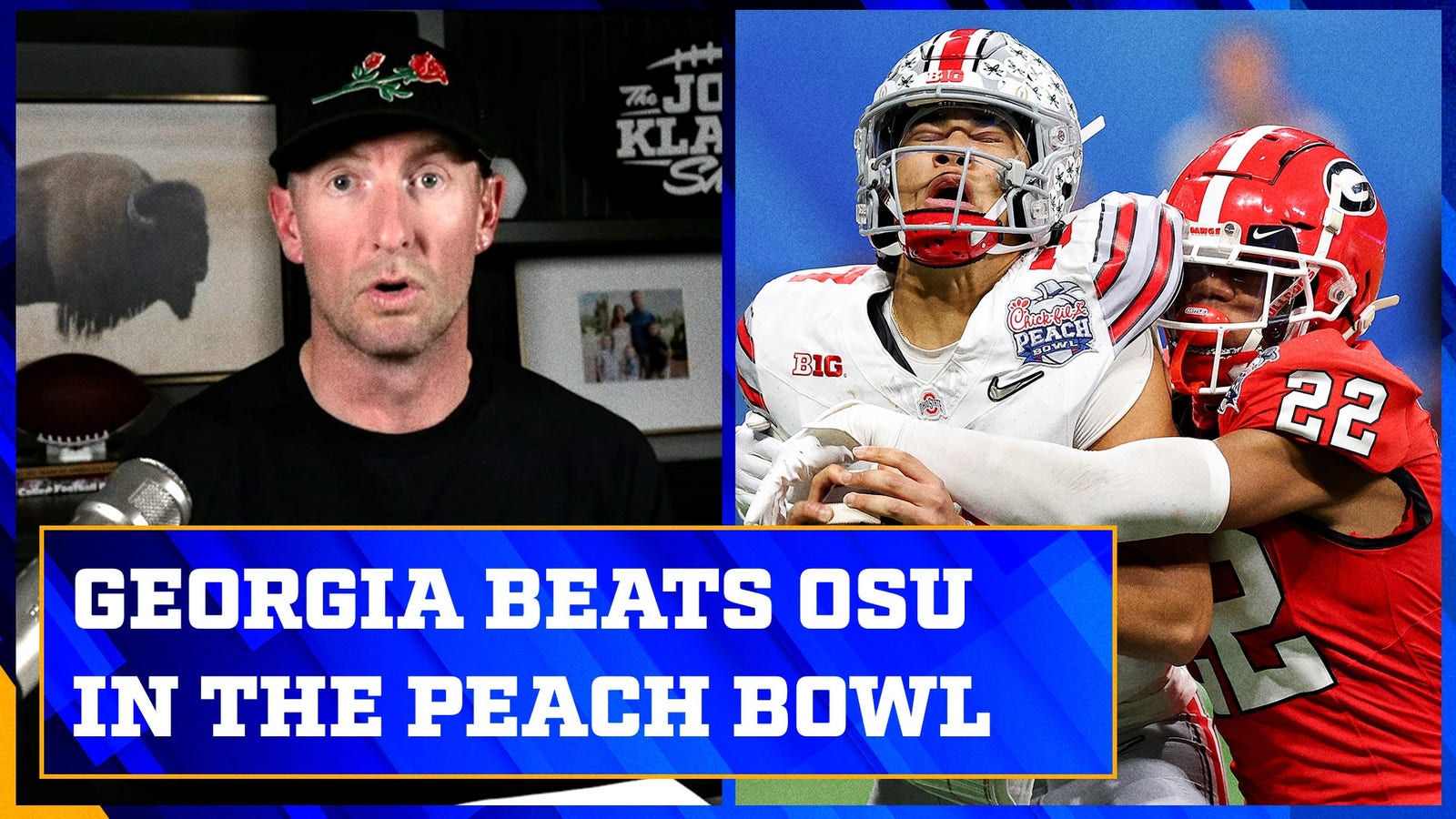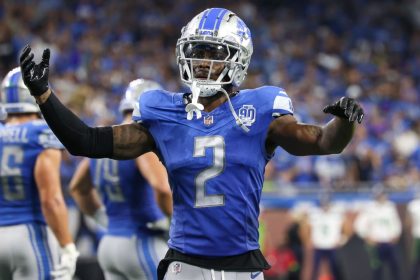The 2022 college football season began 135 days ago across the pond in Ireland between two teams that didn’t have a sniff of the postseason. After a crescendo of College Football Playoff semifinals to close out the calendar year, the season comes to a close on Monday night in Los Angeles, as No. 1 Georgia tries to defend its crown against the true Hollywood story being authored by No. 3 TCU.
Few expected this to be the matchup for the national championship amid the wild twists and turns of this college football campaign, but here we are. Bulldogs vs. Horned Frogs and a chance to firmly etch one of their programs into the record book and add a precious golden trophy into the trophy case.
In many respects, this is a game of contrasting styles that flows directly down from the two opposing head coaches. TCU’s Sonny Dykes is an Air Raid savant, having learned the simple but stressful system from the godfathers of it all — Hal Mumme and Mike Leach. Georgia’s Kirby Smart has made his name on the opposite side of the ball, first as a player under Jim Donnan and then as a coach under Bobby Bowden and Nick Saban. Both are masters at their craft and on the brink of the title not just because they get to coach great players in Athens and Fort Worth, but because they also are great at adapting what they’re running over the years and in a constant state of evolution.
Likewise, Bulldogs offensive coordinator Todd Monken has bounced between the pro and college games picking up plenty of different elements to incorporate into his own system. Opposite number Joe Gillespie spent two decades as a high school coach before rising up the ladder in college the past few years by employing some unique looks in the 3-3-5 alignment.
Add it all up and this year’s championship game has all the makings of a titanic battle between two very good — albeit differing — styles of offenses and defense. Judging by their paths through the Fiesta and Peach Bowls, it’s likely to be a bit higher scoring than both are used to, too.
“Traditionally the teams that are in these games, they’re pretty good offensively. But you’d like to say they’re also pretty good defensively,” Smart noted Tuesday. “I think the studies and numbers indicate that as the season goes on and especially the semifinal and final games, scoring has to be going up.”
Here’s a look at both sides of the National Championship Game and what to watch out for:
Georgia’s offense
The Bulldogs are a rare breed in college football primarily because of one position: tight end.
To start with, they have some absolute stars at a position that is in itself almost completely about creating mismatches in both the running and passing games. Brock Bowers won the Mackey Award as the nation’s best tight end and leads the team in catches, receiving yards and touchdowns. He’s also scored three times on the ground and averages more than 13 yards per rush by using his athleticism and frame to look just as nimble as one of the team’s trio of top tailbacks.
Then there’s Darnell Washington at 6-foot-7 and 270 pounds. Though he is questionable for the title game after suffering an injury against Ohio State, the big junior’s presence typically allows the team to line up in 12 (one back, two tight ends) or 22 (two backs, two tight ends) personnel far more than your typical program does in college football. Having Washington and Bowers in to block on running plays can create advantages and overloads that create daylight for Kenny McIntosh, Daijun Edwards or Kendall Milton to run through.
Those tight ends can also become weapons in the passing game, against either smaller defensive backs or slower linebackers. Toss in a quarterback in Stetson Bennett who thrives at identifying coverages and knowing where to place the ball, and there’s a reason why UGA has had a top-10 scoring offense the past two years.
“That’s the thing that’s unique about this team. Most of the time you play against a good team and there’s two or three guys you say, look, we’ve gotta really take this guy away,” said Dykes. “But Georgia has just so many good players and guys that are really exceptional talents. You can’t go into a game and just say, okay, look, we’re going to — if we take this guy away then they’re going to have problems. That’s not the case with their offense.
“You sit down, look at all the important characteristics for an offense, and they check the box in every single one of those.”
Biggest key: Staying on schedule.
Smart did not seem overjoyed with his offense’s performance in the Peach Bowl, and much of that likely came down to their 2-for-10 effort on third down and the number of times they faced long conversion opportunities throughout their comeback win. Part of that can be blamed on some early Bennett misfires, but also on the run game being overly reliant on big plays and not able to pick up chunks more consistently on the ground.
Michigan found itself in a similar spot against TCU in the Fiesta Bowl, and those pressure-packed situations tended to lead to mistakes more often than not. UGA is at its best when it’s rolling over teams with longer drives and more manageable situations on late downs, something the Dawgs are sure to look to correct in practice during the lead-up to the game.
Keep an eye on formation changes too, as Washington’s injury (Smart said he’s hopeful the tight end will be good to go by kickoff) could either force young freshman Oscar Delp onto the field more, or put even more pressure on wide receivers Arian Smith and Ladd McConkey to open things up in both the intermediate and deep passing game.
TCU’s offense
While Dykes is a first–generation Air Raid disciple, just about every head coach and offensive coordinator put their own unique touches on it. Houston’s Dana Holgorsen has a different variation compared to new North Texas coach Eric Morris. There’s a reason why TCU OC Garrett Riley attacks defenses in different ways from his older brother Lincoln at USC, even if both use a similar playsheet not much bigger than an index card.
The Horned Frogs rank fourth in the country in scoring this season but do so with remarkable balance, rushing for just over 204 yards per game while throwing for a tick under 270 each time out. Much of that is directly attributable not just to philosophy, but also because of the guy running the show in Heisman runner-up Max Duggan.
“He’s got great players to do it with. He understands defenses. I think he’s very smart. There’s no defense he’s going to see that he hasn’t seen before. You’re not tricking an experienced quarterback,” Smart said of TCU’s veteran behind center. “They have a system to allow him to manage that and to get back to third downs where you’ve got a shot to convert them.”
TCU finds the bulk of its success with four receivers on the field and just one tailback next to (or behind) Duggan. Quentin Johnston draws the most attention of the bunch, first for his size at 6-foot-4 but also because of the way he finds soft spots against zone coverage or just straight-up blows past defenders in man using his speed. He’s not the only one though, as Taye Barber and Derius Davis each are extremely dangerous and benefit when teams try to roll coverage toward Johnston. Tight end Jared Wiley is basically an additional tackle in the run game at 6-foot-7 and does a good job pulling when needed, too. He’s also hauled in four touchdowns on the year and gives additional looks when split out to create mismatches.
All of this sets up a rushing attack that scored 36 times and churned out big plays in pretty much every situation. Starting running back Kendre Miller (7.1 yards per carry) is questionable for the title game, but backup Emari Demercado has proven to be more than capable of shouldering the load, rushing for 150 yards against Michigan and breaking off a long touchdown run. As added motivation Monday night, he grew up just a few blocks away from SoFi Stadium in Inglewood.
Meanwhile, Duggan has been nails for the team in leading comeback wins in nearly every game during the regular season. He is much better than his numbers in the semifinal would indicate (14-for-29, 225 yards, two TDs, two INTs) but is heavily involved with designed QB runs and scrambling to buy time for his receivers to come open.
Keys: Stressing across, stressing downfield
As Ohio State showed, you can find some success against the Bulldogs with your passing attack, as their secondary is the weakest of the three levels under Smart this season. TCU often utilizes formations maximizing the entire width of the field and will need to continue to do so in the title game, with receivers lining up outside the numbers pulling defenders away from the box and out of their traditional lanes. Kent State found some success doing this earlier in the season, and there’s no reason to think the Horned Frogs can’t get something going and even bake it into their typically successful screen game, too.
At the same time, Dykes and Duggan will have to stay aggressive and pick good spots to take shots at big plays. They’ve been phenomenal at dialing things up for either long touchdowns or big chunk yardage and will need to keep that rolling if they want to have a shot at winning it all.
Georgia’s defense
Smart has had a hand in some of the great defenses in college football history, including the Bulldogs group last season that was among the best statistically in the game, and produced five first–rounders and eight total picks on that side of the ball.
What’s wild to think about is not just that the team has reloaded so well, but they’ve got the talent to match between the lines — all of which starts up front with big man Jalen Carter. The defensive lineman had a fairly quiet outing against the Buckeyes on New Year’s Eve but is a load in the middle and could end up as the No. 2 overall pick this spring. Carter’s strength is quickly apparent anytime he’s double-teamed, but he has the ability to dart inside and provide plenty of pass rush in the interior to disrupt opposing signal-callers.
It helps that Georgia can throw a variety of looks at you depending on the formation, and also has the speed at the second level to make up for the rare missed assignment out of Will Muschamp and Glenn Schumann’s defense. Linebacker Jamon Dumas-Johnson has stepped up in a big way after Nolan Smith was injured and Smael Mondon Jr. leads the team in tackles while stuffing many of the other statistical categories.
On the back end, the group has plenty of talent with guys like Kelee Ringo and consensus All-American safety Christopher Smith — even if they haven’t quite lived up to it in spurts this season.
“Ohio State made some big plays against them, particularly in the passing game. And I’m sure they’re going to work to get some of those issues addressed,” said Dykes. “Georgia is not accustomed to giving up that many points, but you got to see what Georgia is all about in the fourth quarter of that game. And you got to see what kind of team they have because they responded and did exactly what you would expect them to do, found a way to win.”
Biggest key: Spying on Max.
Georgia has done a fairly solid job against pretty much every opponent this season but will need to be extra aware of Duggan on both designed runs/draws as well as his scramble ability up the middle. Smart has typically kept an extra defender back to guard against that and will likely coach everybody on defense that a play isn’t over until the whistle because the signal-caller is so good at keeping things alive and launching it down the field. Tackling will also be paramount in limiting the Horned Frogs given how often they seem to turn a little daylight into long gains.
TCU’s defense
The 3-3-5 defense and various iterations of it have been floating around college football for several decades, but it truly hits the spotlight on Monday night when coordinator Joe Gillespie will try to replicate what he did in the Fiesta Bowl by producing a pair of pick-sixes and host of other big plays against a similarly physical offense that has a decided size advantage.
Among the five defensive backs, the one to keep an eye out for first is Tre’Vius Hodges-Tomlinson. The Thorpe Award winner relishes his role as a shutdown corner, but don’t overlook how he contributes in flying around on tackles in the run game or on rallying for plays over the middle. The safeties behind him can provide help over the top but move around constantly, providing a difficult read for opposition quarterbacks as they generally don’t line up where you would typically see them twice in the same spot.
Just as key are the linebackers, who are as comfortable shooting gaps to make plays in the backfield as they are dropping into coverage and utilizing their speed. The base alignment makes it different for pulling linemen to pick them up and they create a different angle of attack for teams used to playing even fronts (i.e. a 4-3 alignment).
“I think it’s just simplifying the defense, allowing us to play fast. Just flying around,” senior Dee Winters said. “Coach Gillespie preaches that we’re going to make mistakes, it’s inevitable. But he wants us to go out there and have fun. And he constantly reminds us at the end of the day it’s football and just play fast.”
What got the Horned Frogs to the final game of the year, though, was their physicality. They racked up 13 tackles for loss against the Wolverines in the desert, and defensive lineman Dylan Horton alone posted four sacks of QB J.J. McCarthy. They’ll need to match every bit of that against UGA to keep things even in the trenches.
Biggest key: Pressure and passing lanes.
While Jim Harbaugh’s offense seemed to be caught completely off-guard by TCU’s defensive formation, the concept isn’t completely foreign for the Bulldogs, as Mississippi State’s Zach Arnett is a Rocky Long disciple and runs a scheme with similar elements. UGA won 45-19 in their meeting in Starkville back in November, putting up nearly 500 yards of total offense in the convincing win.
“Mississippi State is very different. They’re not really 3-3-5 compared to these guys,” noted Smart. “Just not the same structure. It’s not the same looks that they provide. There’s different coverage structures. There’s different elements to it. There’s different personnel groupings, different techniques with inside, different styles of plays than those guys.”
Still, when presented with some of the odd front looks from MSU, Bennett wound up tossing two interceptions and the offense nearly had an additional red-zone turnover as well. Last week, McCarthy failed to see several of the TCU linebackers and safeties as they ended up in unexpected passing lanes, and the Horned Frogs will hope to do something similar whether they are bringing additional pressure or not.
Also, keep in mind that Bennett (5-foot-11) is far from ideal height at quarterback, so any hands in his face or defenders in his line of vision could make him extra uncomfortable in the pocket and cause just that extra bit of hesitation that leads to turnovers or missed opportunities.
Sadly for college football, the season will come to an end Monday night. Luckily, however, the fitting finale to the season has the chance to be a fantastic chess match as these teams battle it out for the right to become national champions.
Read more:
Top stories from FOX Sports:
Bryan Fischer is a college football writer for FOX Sports. He has been covering college athletics for nearly two decades at outlets such as NBC Sports, CBS Sports, Yahoo! Sports and NFL.com among others. Follow him on Twitter at @BryanDFischer.

Get more from College Football Follow your favorites to get information about games, news and more













